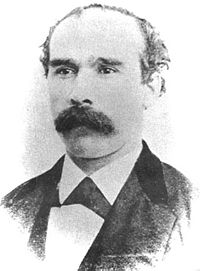| Alexander Campbell | |
|---|---|
 Alexander Campbell Alexander Campbell | |
| Born | c. 1833 Dungloe, County Donegal, Ireland |
| Died | 1877 (aged 43–44) Mauch Chunk, Pennsylvania, U.S. |
| Cause of death | Execution by hanging |
Alexander Campbell (c. 1833 – June 21, 1877) was a tavern owner, who, with three other convicted Molly Maguires, was hanged for the murders of two mine operatives.
Campbell proclaimed his innocence to the end, and in doing so, slapped a muddy handprint on the wall of his prison cell, declaring the mark would remain forever as a sign of his innocence. Legend has it that despite many attempts to remove it, including building a new wall, the mark still remains today.
Life
Campbell was born in Dungloe, County Donegal, Ireland around 1833. In 1868, he emigrated to the United States, where he began operating a tavern in the eastern Pennsylvania town of Tamaqua. Campbell later moved to Storm Hill in Lansford, where he served as a recruiter for the Ancient Order of Hibernians. He became a hotel owner, and liquor distributor, and was allegedly a member of the Mollies. This was a term used in the Pennsylvanian coal mining counties Carbon and Schuylkill by miners, mainly Irish immigrants, to describe those who took part in organized labor movements and violently resisted conscription.
Crime and punishment
The Molly Maguires were generally seen, outside their circle of supporters, as murderers, terrorists, and foreign agitators. In 1877, along with three other men (Michael Doyle, John Donahue and Edward Kelly), Campbell was convicted of the murders of John P. Jones and Morgan Powell, but he admitted to only being an accessory. Evidence collected was presented by a single detective from the Pinkerton Agency.
The convicts were taken to Carbon County Jail, and Campbell was assigned to cell #17. For days they were forced to listen to the noise made whilst the gallows were being built, outside in the courtyard. On the morning of execution, the courtyard was packed with people. The convicts kept their dignity, but when the guards went to fetch Campbell, he tried one last time to proclaim his innocence. When they refused to let him go, he put his hand in the dirt, and marked the wall with it, stating the mark would remain forever as a sign of his innocence. All four men were then hanged.
The handprint
The handprint Campbell left is still there today, although the wall has been washed, painted over, and, according to some versions, even knocked down and replaced. A forensic scientist who examined the handprint with infrared photography in the 1990s concluded that it had never been painted over, and stated that the history of Campbell's execution suggests a right hand print on the wall, rather than the left hand print that is currently visible. The prison is listed on the National Register of Historic labor conflicts.
Pennsylvania legislature
Both branches of the Pennsylvania legislature have passed resolutions (House Resolution No. 527, Session of 2005, and Senate Resolution No. 235 Session of 2006) asserting that the trial of Campbell and the three other accused Molly Maguires was "inherently unconstitutional."
References
- ^ "Molly Maguires". Retrieved 2007-07-21.
- ^ "The Handprint". Archived from the original on May 17, 2007. Retrieved 2007-06-26.
- ^ O'Donnell, Matt (2007-06-01). "The Ghostly Handprint". An Action News Special Report. ABC News. Archived from the original on 2012-08-12. Retrieved 2007-06-26.
- ^ "paw-history". Archived from the original on 22 June 2007. Retrieved 2007-06-26.
- "Welcome To Jim Thorpe, Pennsylvania". Archived from the original on June 30, 2007. Retrieved 2007-06-26.
- ^ "The myth of the Molly Maguires, an Irish rebel group in America". The Crime library. Archived from the original on 2008-06-05. Retrieved 2007-06-26.
- "Famous haunted crime scenes & stories about them Crime Library - The Crime library". Archived from the original on 2008-05-31. Retrieved 2007-06-26.
- "Carbon County Jail". National Register of Historic Places Delaware and Lehigh National Heritage Corridor Travel Itinerary. Retrieved 2007-06-27.
- "HR527".
- "SR235".
- 1830s births
- 1877 deaths
- 1877 murders in the United States
- Drinking establishment owners
- 19th-century executions of American people
- People executed by Pennsylvania by hanging
- American people executed for murder
- Executed people from County Donegal
- 19th-century executions by the United States
- 19th-century American businesspeople
- People convicted of murder by Pennsylvania
- People from Dungloe
- Irish emigrants to the United States